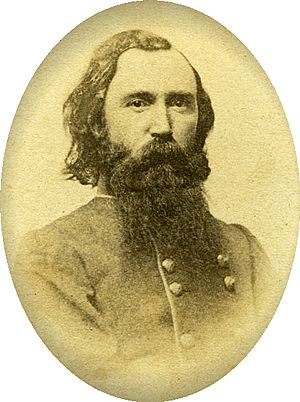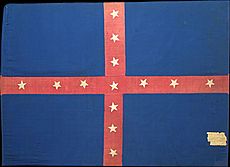Archibald S. Dobbins facts for kids
Quick facts for kids
Archibald S. Dobbins
|
|
|---|---|

Dobbins in uniform, c. 1862
|
|
| Born |
Archibald Stephenson Dobbins
c. 1827 |
| Disappeared | c. 1878 (aged 51) Patagonia (present-day Santa Cruz Province), Argentina |
| Status | Missing for 148 years and 11 days |
| Monuments | Dobbins Memorial Marker, Confederate Cemetery, Helena, Arkansas |
| Occupation | |
| Spouse(s) |
Mary P. Dawson
(m. 1849) |
| Children | 3 |
| Military service | |
| Allegiance | Confederate States |
| Branch | Confederate States Army |
| Years of service | 1862–1865 |
| Rank | Colonel |
| Commands held |
|
| Battles | |
Colonel Archibald Stephenson Dobbins (c. 1827 – c. 1878) was an officer in the Confederate army. He led a cavalry regiment during the American Civil War in the Trans-Mississippi Theater. Dobbins was involved in a disagreement with another general, John S. Marmaduke, which led to a military trial. However, his punishment was later removed, and he returned to duty.
After the war, Dobbins became a merchant in New Orleans. He later moved to Brazil and then to Argentina. The exact details of his disappearance in Patagonia around 1878 are still a mystery.
Contents
Early Life and Moving West
Archibald Stephenson Dobbins was born around 1827 in Maury County, Tennessee. His parents were David and Catherine Dobbins. After marrying Mary Patience Dawson, he moved to Coahoma County, Mississippi. Later, he settled in Phillips County, Arkansas. There, he bought a large farm called Horse Shoe Island Plantation, near Helena.
Service in the American Civil War
In the summer of 1862, Major-General Thomas C. Hindman became the leader of the District of Arkansas. He brought Dobbins with him from Mississippi to Little Rock. Dobbins served as a volunteer aide, helping the general.
After the Battle of Prairie Grove, Dobbins was made a colonel. He was put in charge of a new group of soldiers known as "Dobbins' cavalry regiment." This regiment was part of a larger military group led by Brigadier-General Lucius M. Walker. Dobbins' cavalry fought in many battles and small fights across the Trans-Mississippi Department.
Disagreement and Return to Duty
General Walker was killed in a duel with another general, John S. Marmaduke. After this, Dobbins took command of Walker's cavalry division. However, when Marmaduke took charge at the Battle of Bayou Fourche, Dobbins refused to serve under him. Marmaduke ordered Dobbins' arrest.
Dobbins had a military trial at Camp Bragg, Arkansas, on November 23, 1863. He was found guilty of not following orders. But President Jefferson Davis later canceled the punishment. Dobbins then returned to his duties in the Trans-Mississippi Department for the rest of the war. He was released as a prisoner of war in Galveston, Texas, on July 13, 1865.
Life After the War
After the Civil War ended, Dobbins started a business in New Orleans. In 1867, he and his brother moved to the Para region of Brazil. Two years later, he asked his wife and children to join him there. However, the letters stopped coming as his wife was making travel plans.
In June 1878, records show that Dobbins moved to the Patagonia region of Argentina. There, he was involved in business. An article from 1881 in The Standard newspaper mentioned that Dobbins had helped eight Scottish settlers travel to Port Desire, Argentina, five years earlier.
What Happened to Dobbins?
The exact reasons for Dobbins' disappearance are unknown. Some ideas include that he might have died naturally in Patagonia. Other theories suggest he might have been harmed by local people. There is also a theory that he simply wanted to leave his family behind. His fate remains a mystery.
Monuments and Memorials
There is a memorial for Dobbins in a cemetery in Helena, Arkansas. It is a cenotaph, which means it honors him even though his body was never found.
See Also
- List of people who disappeared


